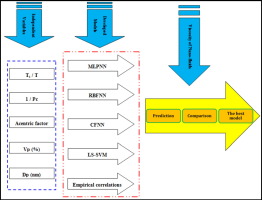当前位置:
X-MOL 学术
›
Powder Technol.
›
论文详情
Our official English website, www.x-mol.net, welcomes your
feedback! (Note: you will need to create a separate account there.)
Prediction of viscosity of several alumina-based nanofluids using various artificial intelligence paradigms - Comparison with experimental data and empirical correlations
Powder Technology ( IF 4.5 ) Pub Date : 2018-01-01 , DOI: 10.1016/j.powtec.2017.10.038 Ehsan Gholami , Behzad Vaferi , Mohammad Amin Ariana
Powder Technology ( IF 4.5 ) Pub Date : 2018-01-01 , DOI: 10.1016/j.powtec.2017.10.038 Ehsan Gholami , Behzad Vaferi , Mohammad Amin Ariana

|
Abstract Nanofluids have recently been considered as one of the most popular working fluid in heat transfer and fluid mechanics. Viscosity is one of the most important thermo-physical properties that influence both momentum and heat transported by the nanofluids. Accurate estimation of this parameter is required for investigation the heat transfer performance of nanofluids. Therefore, in this study 1 - the most influential variables on viscosity of the nanofluids are determined 2 - various artificial intelligence (AI) models are developed for prediction of viscosity of alumina nanoparticle in various base fluids, 3 - by comparing predictive accuracy of the developed models and available empirical correlations, the best one is selected. Correlation matrix analyses confirmed that the reduced pressure, invers of reduced temperature, acentric factor of the base fluids, and diameter and volume concentration of the nano particles in base fluids are the most influential independent variables on viscosity of nanofluids. Various statistical indices including mean square errors (MSE), root mean square errors (RMSE), average absolute relative deviation percent (AARD%), and regression coefficient (R2) are used for numerical evaluation of accuracy of various models. The results demonstrate that predictive accuracy of the multi-layer perceptron neural network (MLPNN) outperforms other intelligence/empirical models, and therefore it was considered as the best approach for the considered task. This model predicted the viscosity of various alumina-based nanofluids with overall MSE = 0.1422, RMSE = 0.3797, AARD = 4.13%, and R2 = 0.99947. Based on our best knowledge, this study is the only work that compared the performance of various intelligent/empirical paradigms for estimation of viscosity of various alumina-based nanofluids.
中文翻译:

使用各种人工智能范式预测几种氧化铝基纳米流体的粘度 - 与实验数据和经验相关性的比较
摘要 纳米流体最近被认为是传热和流体力学中最流行的工作流体之一。粘度是影响纳米流体传输的动量和热量的最重要的热物理特性之一。研究纳米流体的传热性能需要准确估计该参数。因此,在本研究中 1 - 确定了对纳米流体粘度影响最大的变量 2 - 开发了各种人工智能 (AI) 模型来预测各种基础流体中氧化铝纳米颗粒的粘度,3 - 通过比较已开发的预测精度模型和可用的经验相关性,选择最好的一个。相关矩阵分析证实,降低的压力,降低的温度的倒数,基液的偏心因子、基液中纳米颗粒的直径和体积浓度是对纳米流体粘度影响最大的自变量。各种统计指标包括均方误差(MSE)、均方根误差(RMSE)、平均绝对相对偏差百分比(AARD%)和回归系数(R2),用于对各种模型的精度进行数值评估。结果表明,多层感知器神经网络 (MLPNN) 的预测准确性优于其他智能/经验模型,因此它被认为是所考虑任务的最佳方法。该模型预测了各种基于氧化铝的纳米流体的粘度,总体 MSE = 0.1422、RMSE = 0.3797、AARD = 4.13% 和 R2 = 0.99947。根据我们最好的知识,
更新日期:2018-01-01
中文翻译:

使用各种人工智能范式预测几种氧化铝基纳米流体的粘度 - 与实验数据和经验相关性的比较
摘要 纳米流体最近被认为是传热和流体力学中最流行的工作流体之一。粘度是影响纳米流体传输的动量和热量的最重要的热物理特性之一。研究纳米流体的传热性能需要准确估计该参数。因此,在本研究中 1 - 确定了对纳米流体粘度影响最大的变量 2 - 开发了各种人工智能 (AI) 模型来预测各种基础流体中氧化铝纳米颗粒的粘度,3 - 通过比较已开发的预测精度模型和可用的经验相关性,选择最好的一个。相关矩阵分析证实,降低的压力,降低的温度的倒数,基液的偏心因子、基液中纳米颗粒的直径和体积浓度是对纳米流体粘度影响最大的自变量。各种统计指标包括均方误差(MSE)、均方根误差(RMSE)、平均绝对相对偏差百分比(AARD%)和回归系数(R2),用于对各种模型的精度进行数值评估。结果表明,多层感知器神经网络 (MLPNN) 的预测准确性优于其他智能/经验模型,因此它被认为是所考虑任务的最佳方法。该模型预测了各种基于氧化铝的纳米流体的粘度,总体 MSE = 0.1422、RMSE = 0.3797、AARD = 4.13% 和 R2 = 0.99947。根据我们最好的知识,











































 京公网安备 11010802027423号
京公网安备 11010802027423号